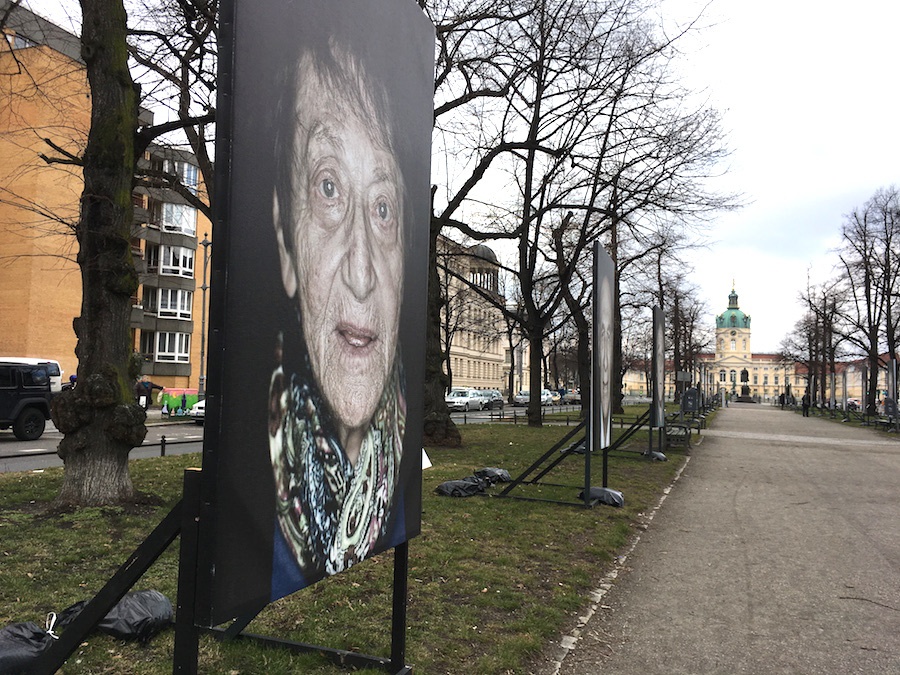
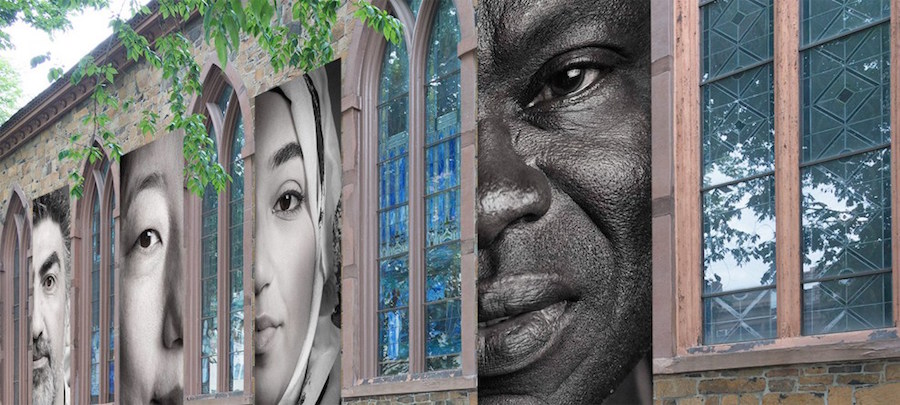 "I’ve taken our privileges, our freedoms, for granted. So I want to hear the voices of immigrants express their drive and their desire with the hope that Americans can learn from that." Rendering courtesy of the artist.
"I’ve taken our privileges, our freedoms, for granted. So I want to hear the voices of immigrants express their drive and their desire with the hope that Americans can learn from that." Rendering courtesy of the artist.
You’re walking through the New Haven Green when you notice the faces. A cluster of them, wrinkles and birthmarks and all, towering high above eye level.
An eye, then a cheek, reveal themselves. Just a few feet away, there’s a smile framed by the soft folds of a hijab. Then another, with trusting pupils that follow you as you move. New friends, to greet you on your walk.
Those faces will land on the New Haven Green in June, as the first stage of “WE ARE: A Nation of Immigrants-New Haven” a large photo installation planned for the sides of Trinity, Center and United Churches on the New Haven Green. Organized, shot and curated by photographer Joe Standart, the installation will feature photos of New Haven’s immigrant community, with QR codes by each image linking to audio and video stories.
In all, “WE ARE” will include 14 portraits printed on aluminum and snuggled in stainless steel frames, each measuring 9 x 25 feet. A second 48 x 68 foot installation is planned for the side of the iconic Pirelli Building, where artist Tom Burr had an inglorious homecoming last year. As of Tuesday, Standart said he had shot about 55 images and recorded almost as many stories in audio and video together. He has been working out of a makeshift studio at 129 Church Street, across from the site of the project, with the blessing of the Proprietors of the New Haven Green. None of them were available for comment for this article.
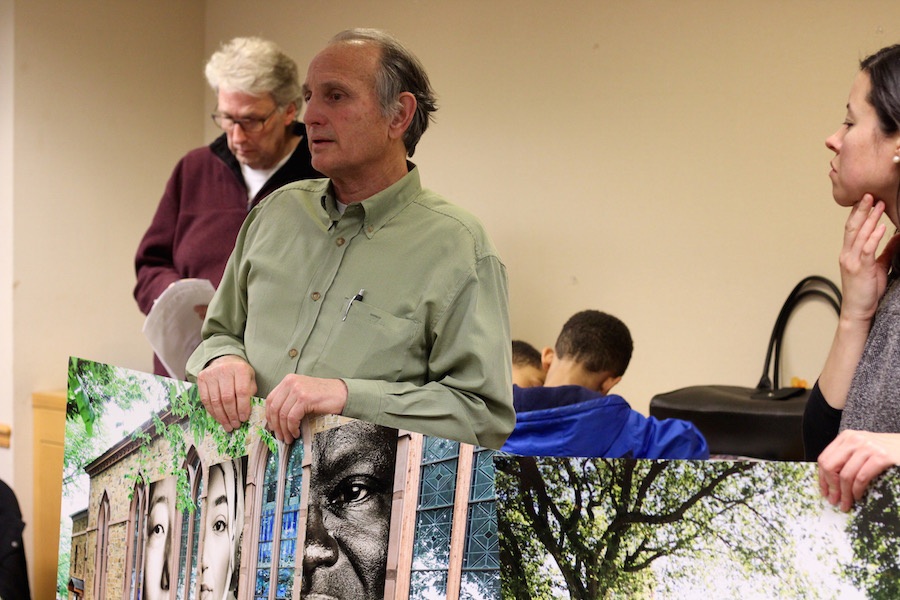 Standart and Lucy McClure at the Meeting. Lucy Gellman Photo.
Standart and Lucy McClure at the Meeting. Lucy Gellman Photo.
“Our nation was born on the backs and imaginations of immigrants and has grown organically that way,” he said Tuesday night, presenting the project to the Downtown Wooster Square Community Management Team (DWSCMT). “They have fought to be here. And looking around America today … I’ve taken our privileges, our freedoms, for granted. So I want to hear the voices of immigrants express their drive and their desire with the hope that Americans can learn from that.”
A Michigan transplant who has lived in Connecticut for much of his life, Standart started the project last year, after thinking about both the history of the New Haven Green and the centuries of migration immigrants into New Haven. In the fall, he reached out to the three churches on the upper New Haven Green, who he said were all “hugely receptive” to the project. Since, each of them have signed on to house images on their windows, walls, steps and surrounding perimeters.
 Randi McCray: “How do they feel about this conversation? How do they feel about the exhibit? What didn’t they know before?" Lucy Gellman Photo.
Randi McCray: “How do they feel about this conversation? How do they feel about the exhibit? What didn’t they know before?" Lucy Gellman Photo.
He has since added community partners: Nasty Women New Haven Co-Founder Lucy McClure, herself a photographer and an immigrant, and Urban Collective Director and Owner Randi McCray, who took for Elinor Slomba earlier this year. With Standart, they are working with Integrated Refugee and Immigrant Services (IRIS), Unidad Latina en Acción (ULA) and Junta for Progressive Action.
“It’s been wonderful to work with all these local organizations but also be able to listen to the stories about all these immigrants, refugees, and understanding their journey—being able to highlight their stories through these portraits,” McClure said at the meeting. “And remove the stigma around the word immigrant and refugee. Being able to open the dialogue for us to communicate with each other and also understand that we all have a history. We all come from somewhere.”
It’s an open air project with longstanding examples in and outside of New Haven: Gegen das Vergessen (Lest We Forget) in Berlin and at the United Nations earlier this year, an International Women’s Day installation currently outside the Musée Curie in Paris, Tom Stoddart’s 2012 Perspectives, a collaboration with the International Committee of the Red Cross for the London Olympic Games, the city’s own ill-fated Inside Out project in 2012 among others.
 A photograph from Luigi Toscano's Gegen Das Vergessen ( Lest We Forget ), installed in Berlin's Charlottenberg neighborhood through this April. The show features remaining WWII survivors and their stories. Lucy Gellman Photo.
A photograph from Luigi Toscano's Gegen Das Vergessen ( Lest We Forget ), installed in Berlin's Charlottenberg neighborhood through this April. The show features remaining WWII survivors and their stories. Lucy Gellman Photo.
Like those shows, it is flecked with complexities and potential criticisms: an outsider with power and means taking intimate images, where the photographer’s trained and lingering eye is always present, and so too his framing of the narrative. A partial story, edited by partial historians.
As they headed out of the meeting, both McCray and McClure said that the team acknowledges that aspect of the exhibition—and is doubling down on community collaborations to make sure that the show is as much about New Haven as it is about the new New Haveners featured, and the photographer working to showcase their stories.
“I keep a constant, open dialogue with Joe—as a woman and as an immigrant,” McClure said. “I always tell him ‘What else can we do?’ It’s so things don’t become this white guy coming into this city, taking photographs of immigrants, and using that as a way of trying to say ‘I feel good. I did something great.’ Because it’s not about that. It shouldn’t be about that.”
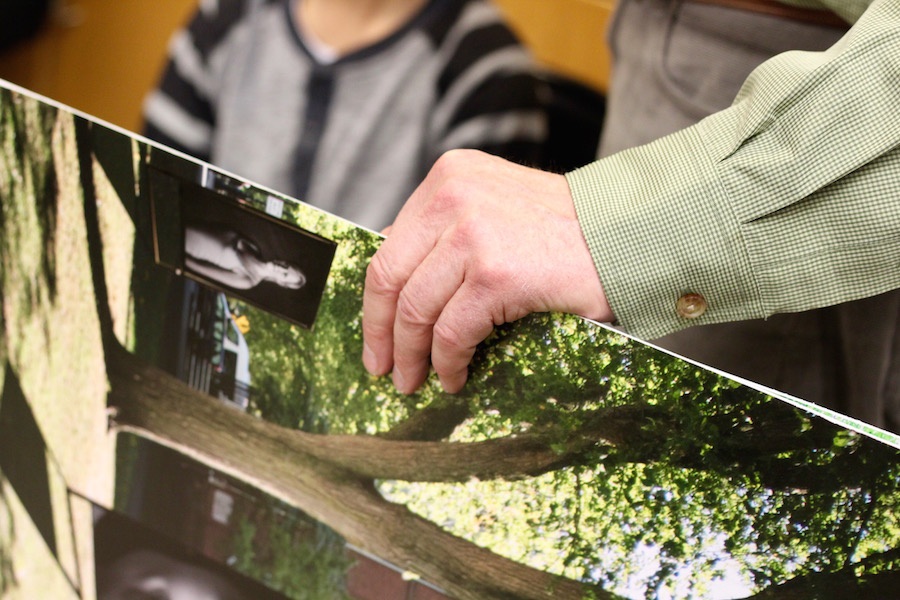 Standart said that he hopes for this installation to be the first phase of a greater “WE ARE: A Nation of Immigrants” presence in New Haven. Lucy Gellman Photo.
Standart said that he hopes for this installation to be the first phase of a greater “WE ARE: A Nation of Immigrants” presence in New Haven. Lucy Gellman Photo.
“It takes a really open dialogue,” she said. “Being honest, being up front, and being nonjudgemental. I think that that’s a big thing. If I had ever felt that this was a white guy coming in and saving the day, I wouldn’t be involved in this project. I would have jumped out a long time ago.”
Part of that is making sure lifetime New Haveners have a stake it “WE ARE,” said McCray. In addition to running the project’s presence on social media, she is in the process of working with students at Gateway Community College on mobile app development, to develop the QR codes that will appear beside each image. Later this spring, she will be training local high school and college students to do visitor interviews and “story collection” with those taking in the exhibition this summer.
“I grew up in New Haven and I realize the complexities of how it feels when people come into the city and do something and people who are not involved feel like ‘Oh, it just popped up,’” she said. “So I’ve been trying to do is assist Joe with getting ahead of it. Let’s let people know it’s coming.”
“We’ll be collecting responses from the community throughout,” she added. “How do they feel about this conversation? How do they feel about the exhibit? What didn’t they know before? What do they know now? So asking all of these questions so we can share that.”
Standart told the DWSCMT he too has reason to think that the project will click—because he’s done it before. “WE ARE” comes as a sequel to “Portrait Of A City: New London,” a 2006 installation that the artist did in New London.
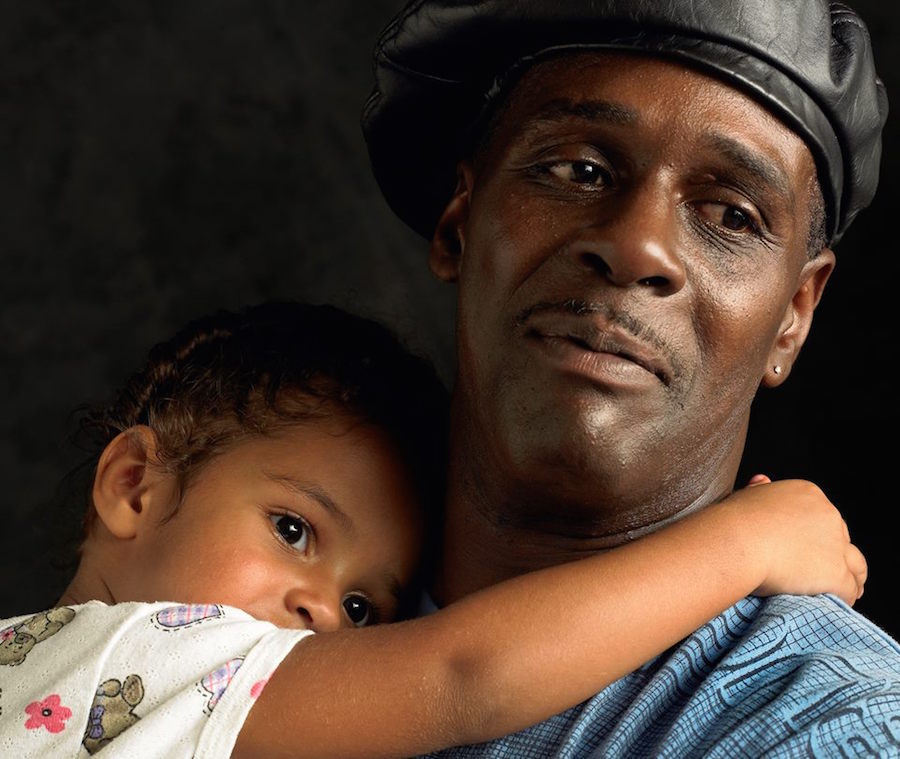 Detail, Eliza and Her Father , from the New London project. Joe Standart Photo.
Detail, Eliza and Her Father , from the New London project. Joe Standart Photo.
For that project, Standart took photos from 2004 to 2006—he estimates 300 in all—of citizens who were walking around downtown New London. They were then installed on the streets of the city, where they had originally been taken. On the exhibition’s 10th anniversary in 2016, Standart brought a selection of the exhibition back, showing several of the prints at the Lyman Allyn Art Museum.
To concerns about defacement of the work from attendee Kevin McCarthy, Standart said he isn’t concerned. While he said that churches leaders have warned him about “the needle problem,” homelessness and panhandling on the Green—a sticking point earlier in the evening—he said he thinks the works, in their larger-than-life format, will garner enough respect to be left alone.
That has not always worked for these types of shows: Berlin’s Gegen das Vergessen has endured drawings of testicles on the faces of Holocaust survivors, and “Inside Out” was tagged within days of going up in New Haven. Standart said there was not yet a plan for taking down and quickly replacing any of the images if tags or other graffiti appear on them.
“In other cities, it’s never really happened,” he said. “People see our work and they really seem to respect it. And I would certainly like to be my own ambassador, in meeting people and trying to gain familiarity.”
Funding for the project remains incomplete. In mid-March, the project received a $20,000 grant from the Community Foundation for Greater New Haven and launched a Kickstarter Campaign to cover a remaining $10,000. IKEA has contributed $5,000 toward the portrait on the side of the Pirelli Building, where it often places advertisements.
The Arts Council of Greater New Haven is acting as a fiscal agent, which means that it can accept donations for the project, but cannot distribute grants for it. Standart said those amounts, with the Kickstarter, cover only the cost of photography and materials, and that he is not making money on the project.
Standart said that he hopes for this installation to be the first phase of a greater “WE ARE: A Nation of Immigrants” presence in New Haven. Standart suggested that in the coming year, he would like to expand the installation to the five branches of the New Haven Free Public Library, City Hall, Hall of Records at 200 Orange Street, and community centers.
Those sites, like the Green, will hopefully encourage viewers to “go explore New Haven” he said. “That’s what public art does so well.”

